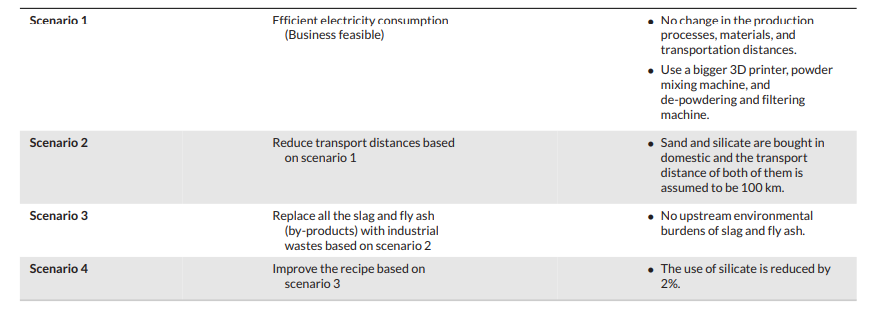In the recently published ‘Life Cycle Assessment of 3D Printing Geo-polymer Concrete: An Ex-ante Study,’ authors Yue Yao, Mingming Hu, Francesco Di Maio, and Stefano Cucurachi examine the development of geo-polymers in concrete, and delve further into the use of 3D printing within the construction industry.
With the environment in mind, the authors are assessing the efficacy of using 3D printing and geo-polymers to replace conventional manufacturing methods with conventional materials like Portland cement. Environmental performance was evaluated through an ex-ante life cycle assessment (LCA), with manufacturer data used to pinpoint items for improvement and ‘scaled-up scenarios’ created in partnership with the company as the researchers looked into areas for improvement.
Waste reduction is high on the list of benefits in terms of 3D printing in construction and with cement, and while geo-polymer could have even higher environmental impacts than ordinary concrete, the study shows that with multiple improvements, it could reduce the carbon footprint. The researchers were able to achieve this by lowering the amount of silicate in geo-polymer ‘recipes.’
Previous studies show that 3D printed buildings are higher in efficiency, lower in emissions, produce less waste, and consume less energy. Ex-ante LCA helps the researchers here evaluate the merits of fabricating a GP concrete object through inkjet 3D printing.
“Aiming at combining environmental management and technology development, in close-collaboration with technology developers, the study shows that ex-ante LCA can not only estimate the potential environmental impacts, but, more importantly, provide directions for the future deployment of 3DPG technology from the current lab-scale experiment,” state the researchers.
There were still some facets of the suggested improvements, however, that would be difficult to integrate in the near future:
“The technology readiness level (TRL; Moorhouse, 2002) of the 3DGP concrete technology in this research is estimated to be 6, which is already on technology demonstration stage,” stated the researchers. “This would suggest using LCA even at an earlier stage of the TRL trajectory to guarantee a greater support of technological innovation, when the core components of a technology are more flexible to change.”
The technology being explored is emerging—just like the accompanying market—but the researchers state that it is also reasonably complex. The researchers worked with technology developers in relation to the following potential for the future:
- Technological landscape
- Market penetration
- Commercial data
- Overall feasibility
The researchers also created numerous scenarios, including those titled ‘what ifs.’
“To generate ‘what-if’ scenarios, hotspots analysis is performed and then four scenarios are developed based on improved hotspots, using the hotspots as building blocks. Thus, hotspots analysis be a structured method to develop scaled-up scenarios in ex-ante LCA studies. For the application of the framework of the ex-ante LCA methodology to other technological systems, additional scenario types and generating methods need to be considered as additional case studies and methodological contributions become available,” stated the researchers.
LCA helps researchers and analysts gain insight into environmental performance, as well as highlighting possible challenges, early on. The authors described this study as going from ‘cradle to gate’ as they analyzed the three stages of the 3DGP concrete system:
- Raw materials
- Transport
- 3DGP concrete manufacturing
Overall, the researchers were concerned with some ‘discrepancies’ regarding 3D printing, attributed to the variances between raw materials, combined with different hardware. Silicate, however, stood out as offering ‘considerable impacts’ on the manufacturing process, and better results.
“The current study setup excludes the use-phase and end-of-life phase for both technology systems. While the environmental impacts of 3DGP concrete and ordinary concrete in the use phase are similar, the collection, treatment, and potential recycling ratio of these two alternatives may be different after utilization,” concluded the researchers.
“3DGP concrete does not have an advantage over ordinary concrete from the perspective of the transportation of raw materials. For ordinary concrete, the supply of raw materials operates at full commercial scale, due to the mature nature of the market. The transportation distances of raw materials are not long for ordinary concrete. These aspects do leave still little room for improvements and rationalization in the use of resources.”
3D printing in the construction industry and with concrete is becoming more common as industrialists realize the enormous advantages, experimenting with reinforcing spatial structures, examining parameters in 3D printed concrete, even 3D printing self-healing capsules for cement.
What do you think of this news? Let us know your thoughts! Join the discussion of this and other 3D printing topics at 3DPrintBoard.com.
[Source / Images: ‘Life Cycle Assessment of 3D Printing Geo-polymer Concrete: An Ex-ante Study’]Subscribe to Our Email Newsletter
Stay up-to-date on all the latest news from the 3D printing industry and receive information and offers from third party vendors.
Print Services
Upload your 3D Models and get them printed quickly and efficiently.
You May Also Like
Metal Powder Supplier Elementum 3D Added to $46B Air Force Contract
Elementum 3D, a Colorado-based developer and supplier of metal powders used in additive manufacturing (AM), announced that the company has been added to the vendors list in the fourth on-ramp...
Ursa Major Lands $28.6M AFRL Deal for 3D Printed Draper Engine Flight Demo
The US Air Force Research Laboratory’s (AFRL’s) Rocket Propulsion Division at Edwards Air Force Base has awarded a $28.6 million contract to Ursa Major for follow-on work related to the...
3D Printing Financials: Rocket Lab’s Record-Breaking Year and Over 20 Launches Coming in 2025
Rocket Lab (Nasdaq: RKLB) closed 2024 with its best year yet. The company launched more rockets, signed more contracts, and expanded deeper into spacecraft and satellite production than ever before....
US Air Force Taps Beehive to Study 3D Printed Jet Engines
Propulsion 3D printing firm Beehive Industries secured a contract from the U.S. Air Force Life Cycle Management Center through SOSSEC. SOSSEC is a company that manages Other Transactions Authority (OTA)...





































